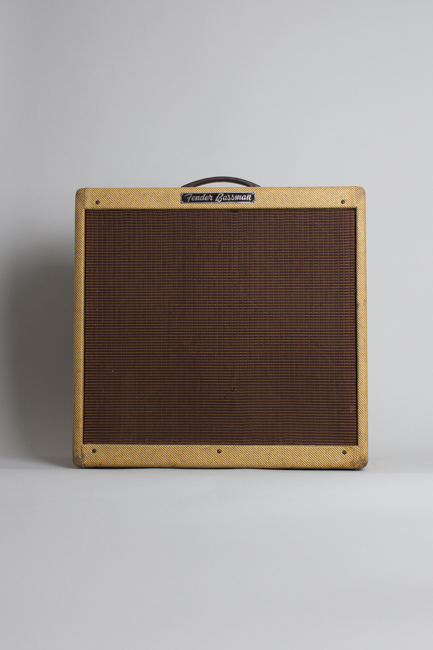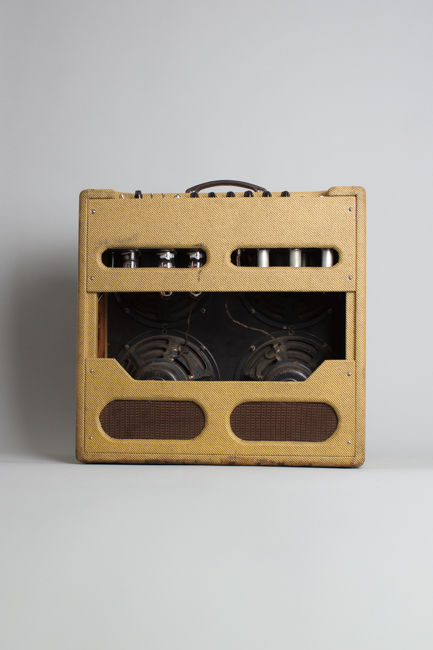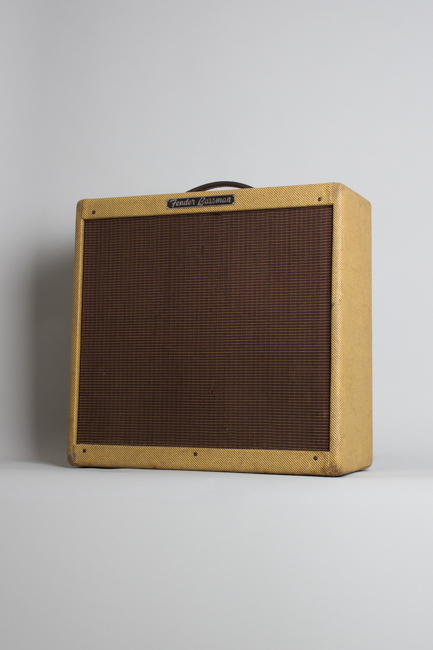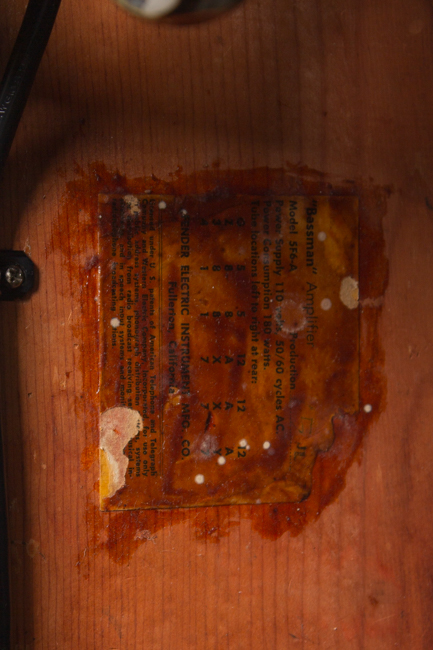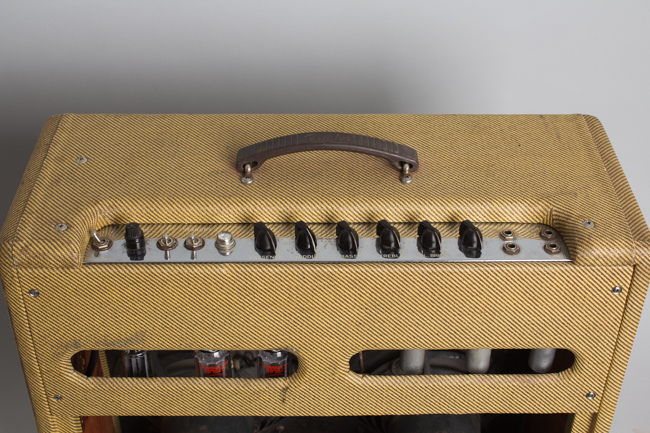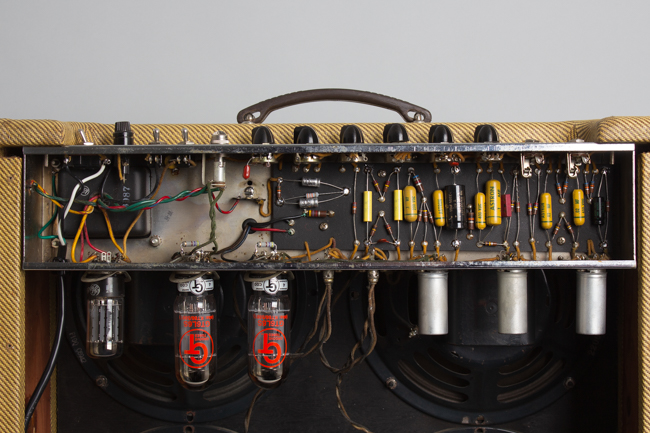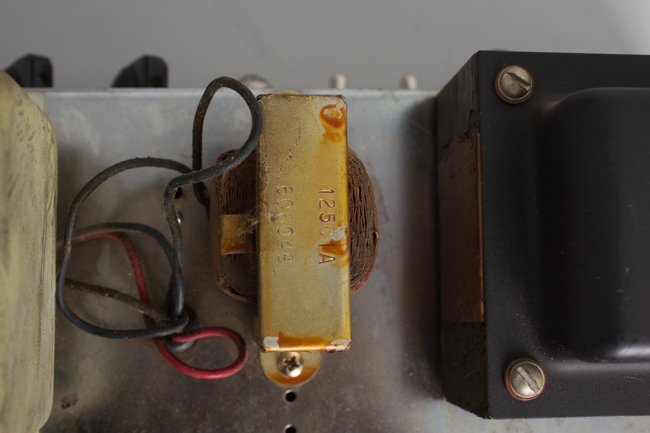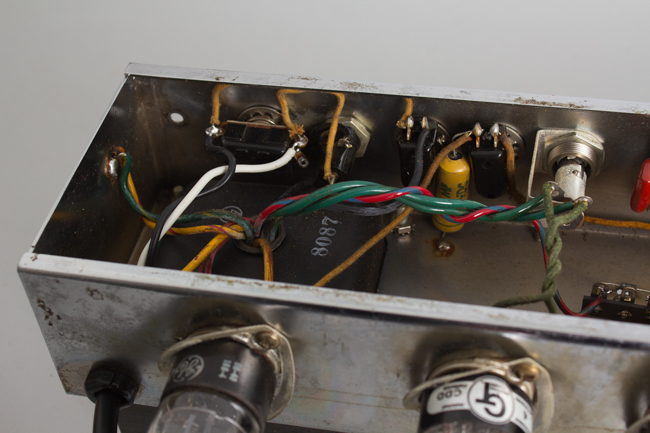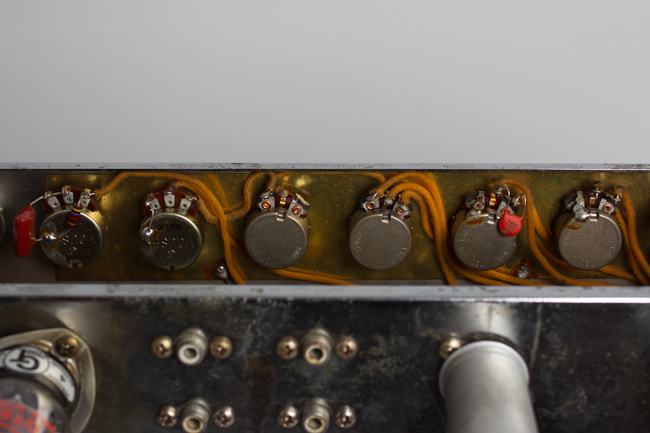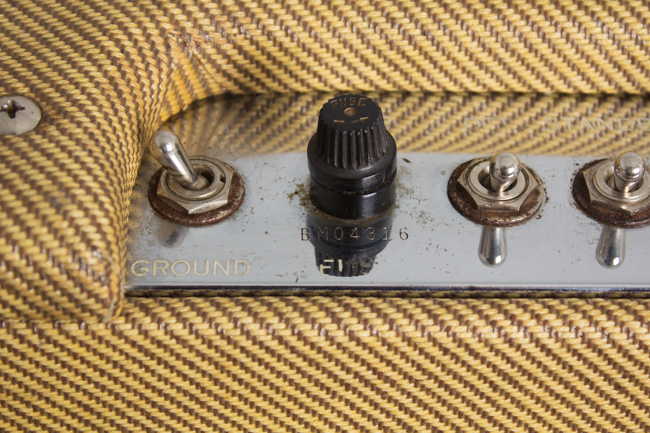Fender Bassman Model 5F6-A Tube Amplifier (1960)
Fender Bassman Model 5F6-A Model Tube Amplifier (1960), made in Fullerton, California, serial # BM-04316, tweed fabric covering finish.
This is a rare and much desired amp for our showroom; an original narrow panel 4X10 tweed Fender Bassman. It has been tastefully re-covered in the correct style tweed but remains otherwise largely original. In any condition this is one of the most coveted and collectible guitar amplifiers of all time, although in one of those great vintage ironies it is not bassists but guitarists who revere this model, widely considered one of the greatest blues/rock amps of all time.
Conceived as a partner for the revolutionary Precision Bass guitar in 1951-2, the first 20 watt, single 15" speaker Bassman amp was intended to amplify "bass, and bass only" according to Fender. This design soon showed several shortcomings for the bass application; over the next few years player opinions and complaints made their way back to Fullerton. The amp struggled to adequately amplify the lowest frequencies of the bass guitar, resulting in undesirable distortion levels. An even more serious issue at the time was the easily blown speaker which posed a huge problem for gigging musicians; if your only speaker blew, you couldn't finish the gig! Fender soon grasped the importance of offering a solidly reliable bass amp; if they could not then the sales of their solidbody electric bass would also suffer!
In 1954, the amp was re-envisioned by Freddie Tavares (with Leo's blessing) as a four 10-inch combo, solving the reliability issues plaguing a single-speaker amp. At this point, Fender also openly recognized the model's growing appeal to guitar, accordion and harmonica players, as the '55 catalog literature states: "Provides true bass amplification or may also be used for other instruments due to its widely varying tonal character." The Bassman has made its presence felt, in design terms, in more subsequent tube amps than any other amplifier. The last revisions, the four-input 5F6 and 5F6-A are perhaps best known for being duplicated by Jim Marshall for the initial JTM-45 amps.
This is a fairly late example of the model; the tube chart bears the stamp JL, indicating an assembly date of December of 1960. This revision now featured a fixed bias output stage allowing for greater headroom and a clearer low-end, alongside a long-tailed-pair phase inverter, both defining characteristics of this era of high-powered tweed models. The push-pull 6L6-powered output section drives four 10" Jensen P10Q speakers yielding around 40 watts of power. Unlike the former versions, this had four inputs and two separate channels, voiced differently; one normal, one bright. The channels each have a dedicated volume control, as well as master treble, bass and presence controls.
Height is 22 1/2 in. (57.2 cm.), 22 1/2 in. (57.2 cm.) width, and 10 1/2 in. (26.7 cm.) in depth at deepest point.
Cosmetically, this amp is in great shape overall; the 're-tweeded' covering is showing some minor wear, mostly just scuffing on the corners. The baffle and grille cloth are original and in great shape overall; the cloth is taut and free of any notable blemishes, save for one or two minor punctures and the baffle shows a commonly seen split that was at one point glued and is structurally sturdy with no apparent issues. The control panel shows minor signs of corrosion but overall retains its shine with most of the stenciled lettering intact. The original rubber handle is still intact and in great shape.
Electrically, the amp remains all original. All four Jensen P10Q speakers are original to the amp with one pair reading 220-023 and the other 220-017, dating them to the 23rd and 17th week of 1960, respectively. The power, choke and output transformers are original to the amp as well and bearing the codes 8087, 606-049 and 45249, the Schumacher-made choke dating to the 49th week of 1960. Pots appear original and date to '60 and '59, save for the Presence and Middle controls, which are newer replacements. The amp has otherwise seen our typical maintenance and servicing, including replacement of all electrolytic capacitors, a 3-prong grounded power cord, cleaning of all sockets, pots and jacks and power tubes biased to spec.
It sounds truly fantastic, with the rip-roaring but highly detailed tone these are justly renowned for especially at higher volumes. It even sounds great with a '50s Fender bass, though few players would combine them today! Overall Restored to Excellent Condition.
This is a rare and much desired amp for our showroom; an original narrow panel 4X10 tweed Fender Bassman. It has been tastefully re-covered in the correct style tweed but remains otherwise largely original. In any condition this is one of the most coveted and collectible guitar amplifiers of all time, although in one of those great vintage ironies it is not bassists but guitarists who revere this model, widely considered one of the greatest blues/rock amps of all time.
Conceived as a partner for the revolutionary Precision Bass guitar in 1951-2, the first 20 watt, single 15" speaker Bassman amp was intended to amplify "bass, and bass only" according to Fender. This design soon showed several shortcomings for the bass application; over the next few years player opinions and complaints made their way back to Fullerton. The amp struggled to adequately amplify the lowest frequencies of the bass guitar, resulting in undesirable distortion levels. An even more serious issue at the time was the easily blown speaker which posed a huge problem for gigging musicians; if your only speaker blew, you couldn't finish the gig! Fender soon grasped the importance of offering a solidly reliable bass amp; if they could not then the sales of their solidbody electric bass would also suffer!
In 1954, the amp was re-envisioned by Freddie Tavares (with Leo's blessing) as a four 10-inch combo, solving the reliability issues plaguing a single-speaker amp. At this point, Fender also openly recognized the model's growing appeal to guitar, accordion and harmonica players, as the '55 catalog literature states: "Provides true bass amplification or may also be used for other instruments due to its widely varying tonal character." The Bassman has made its presence felt, in design terms, in more subsequent tube amps than any other amplifier. The last revisions, the four-input 5F6 and 5F6-A are perhaps best known for being duplicated by Jim Marshall for the initial JTM-45 amps.
This is a fairly late example of the model; the tube chart bears the stamp JL, indicating an assembly date of December of 1960. This revision now featured a fixed bias output stage allowing for greater headroom and a clearer low-end, alongside a long-tailed-pair phase inverter, both defining characteristics of this era of high-powered tweed models. The push-pull 6L6-powered output section drives four 10" Jensen P10Q speakers yielding around 40 watts of power. Unlike the former versions, this had four inputs and two separate channels, voiced differently; one normal, one bright. The channels each have a dedicated volume control, as well as master treble, bass and presence controls.
Height is 22 1/2 in. (57.2 cm.), 22 1/2 in. (57.2 cm.) width, and 10 1/2 in. (26.7 cm.) in depth at deepest point.
Cosmetically, this amp is in great shape overall; the 're-tweeded' covering is showing some minor wear, mostly just scuffing on the corners. The baffle and grille cloth are original and in great shape overall; the cloth is taut and free of any notable blemishes, save for one or two minor punctures and the baffle shows a commonly seen split that was at one point glued and is structurally sturdy with no apparent issues. The control panel shows minor signs of corrosion but overall retains its shine with most of the stenciled lettering intact. The original rubber handle is still intact and in great shape.
Electrically, the amp remains all original. All four Jensen P10Q speakers are original to the amp with one pair reading 220-023 and the other 220-017, dating them to the 23rd and 17th week of 1960, respectively. The power, choke and output transformers are original to the amp as well and bearing the codes 8087, 606-049 and 45249, the Schumacher-made choke dating to the 49th week of 1960. Pots appear original and date to '60 and '59, save for the Presence and Middle controls, which are newer replacements. The amp has otherwise seen our typical maintenance and servicing, including replacement of all electrolytic capacitors, a 3-prong grounded power cord, cleaning of all sockets, pots and jacks and power tubes biased to spec.
It sounds truly fantastic, with the rip-roaring but highly detailed tone these are justly renowned for especially at higher volumes. It even sounds great with a '50s Fender bass, though few players would combine them today! Overall Restored to Excellent Condition.
